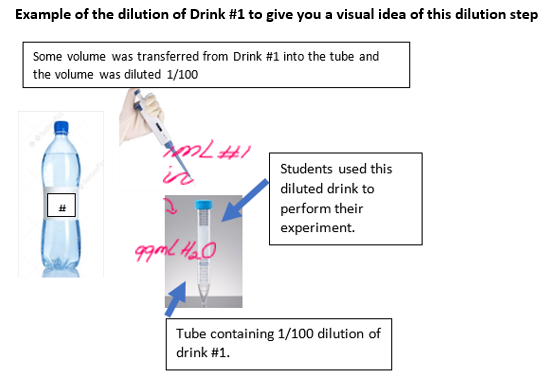Example give lon step Some volume was transferred from Drink #1 into the tube and the volume was diluted 1/100 Students used this is diluted drink to perform their experiment. Tube containing 1/100 dilution of drink #1.
Example give lon step Some volume was transferred from Drink #1 into the tube and the volume was diluted 1/100 Students used this is diluted drink to perform their experiment. Tube containing 1/100 dilution of drink #1.
Chemistry: The Molecular Science
5th Edition
ISBN:9781285199047
Author:John W. Moore, Conrad L. Stanitski
Publisher:John W. Moore, Conrad L. Stanitski
Chapter13: The Chemistry Of Solutes And Solutions
Section13.7: Colligative Properties Of Solutions
Problem 13.17CE
Related questions
Question
- There's 1 drink (and you are asked to determine the glucose concentration in the drink in the units of g/100mL. (Why these units? Well, once you have the concentrations in g/100mL you will be able to compare your values with the nutritional values given on the drink bottles’ labels).
- The sample of the drink was diluted 1/100 (i.e. by a factor of 100). This was an essential step in the method because, without it, the machine used to analyse the glucose concentration (spectrophotometer) would have given an error as the concentration would have been too high for accurate detection. What this means for you is that the dilution factor will need to be taken into consideration in your calculations (remember the aim is to calculate the concentration in the original drink and not in the diluted drink).
- You measured the concentration of their diluted drink using the spectrophotometer and their results were provided to them in the units mM (millimolar).
Glucose Concentration in mM of drink = 2.500 mM
From here, you need to convert the concentration of the drink from mM of the diluted drink into g/100mL of the undiluted drink.
Convert the experimental glucose concentration (mentioned above) from mM (millimolar) to g/100 mL.
Make sure to:
- Take the 1/100 dilution factor into consideration
- Molarity (M) will open the doors for you to get to mass in g.
- Once at M assume 1L of solution. (this will help you when converting from M to moles)
- You will also need to calculate the molar mass of glucose which has the formula C6H12O6
- There are 5 steps in total

Transcribed Image Text:Example of the dilution of Drink #1 to give you a visual idea of this dilution step
Some volume was transferred from Drink #1 into the tube and
the volume was diluted 1/100
Students used this
diluted drink to
perform their
experiment.
Tube containing 1/100 dilution of
drink #1.
Expert Solution
This question has been solved!
Explore an expertly crafted, step-by-step solution for a thorough understanding of key concepts.
This is a popular solution!
Trending now
This is a popular solution!
Step by step
Solved in 3 steps with 3 images

Knowledge Booster
Learn more about
Need a deep-dive on the concept behind this application? Look no further. Learn more about this topic, chemistry and related others by exploring similar questions and additional content below.Recommended textbooks for you

Chemistry: The Molecular Science
Chemistry
ISBN:
9781285199047
Author:
John W. Moore, Conrad L. Stanitski
Publisher:
Cengage Learning

Chemical Principles in the Laboratory
Chemistry
ISBN:
9781305264434
Author:
Emil Slowinski, Wayne C. Wolsey, Robert Rossi
Publisher:
Brooks Cole

Macroscale and Microscale Organic Experiments
Chemistry
ISBN:
9781305577190
Author:
Kenneth L. Williamson, Katherine M. Masters
Publisher:
Brooks Cole

Chemistry: The Molecular Science
Chemistry
ISBN:
9781285199047
Author:
John W. Moore, Conrad L. Stanitski
Publisher:
Cengage Learning

Chemical Principles in the Laboratory
Chemistry
ISBN:
9781305264434
Author:
Emil Slowinski, Wayne C. Wolsey, Robert Rossi
Publisher:
Brooks Cole

Macroscale and Microscale Organic Experiments
Chemistry
ISBN:
9781305577190
Author:
Kenneth L. Williamson, Katherine M. Masters
Publisher:
Brooks Cole

Chemistry: Principles and Practice
Chemistry
ISBN:
9780534420123
Author:
Daniel L. Reger, Scott R. Goode, David W. Ball, Edward Mercer
Publisher:
Cengage Learning

Chemistry: Principles and Reactions
Chemistry
ISBN:
9781305079373
Author:
William L. Masterton, Cecile N. Hurley
Publisher:
Cengage Learning
